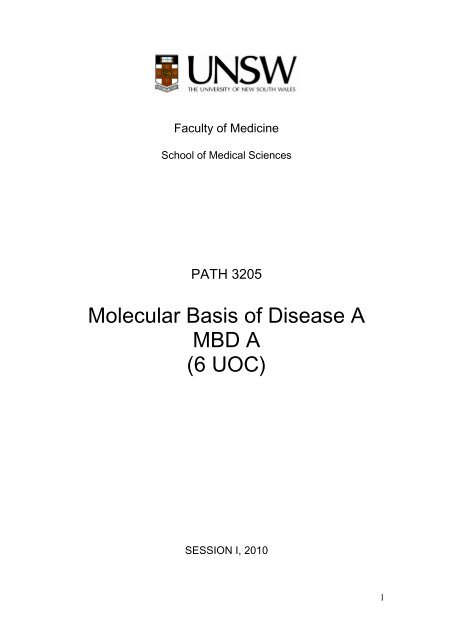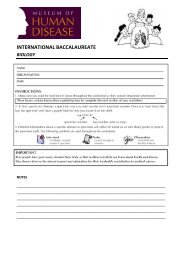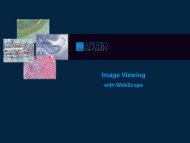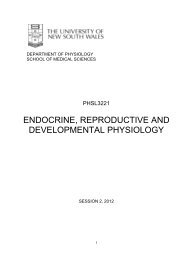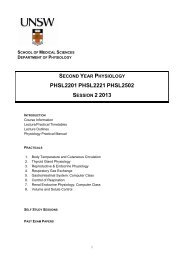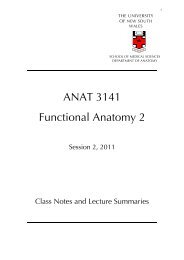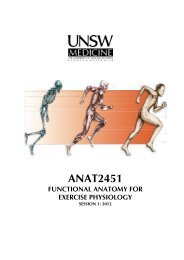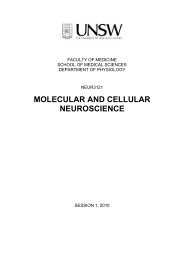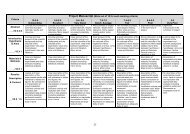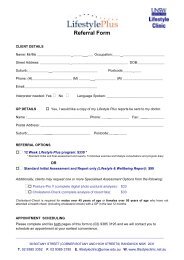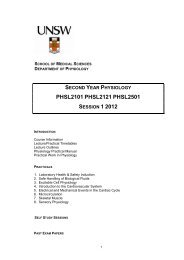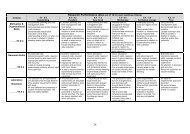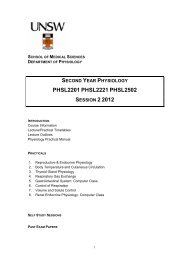Molecular Basis of Disease A MBD A (6 UOC) - School of Medical ...
Molecular Basis of Disease A MBD A (6 UOC) - School of Medical ...
Molecular Basis of Disease A MBD A (6 UOC) - School of Medical ...
You also want an ePaper? Increase the reach of your titles
YUMPU automatically turns print PDFs into web optimized ePapers that Google loves.
Faculty <strong>of</strong> Medicine<br />
<strong>School</strong> <strong>of</strong> <strong>Medical</strong> Sciences<br />
PATH 3205<br />
<strong>Molecular</strong> <strong>Basis</strong> <strong>of</strong> <strong>Disease</strong> A<br />
<strong>MBD</strong> A<br />
(6 <strong>UOC</strong>)<br />
SESSION I, 2010<br />
1
CONTENTS<br />
Page<br />
Course objectives 03<br />
Course staff 03<br />
Course administration 04<br />
Course details 04<br />
Course aims 04<br />
Student learning outcomes 05<br />
Learning and teaching rationale 05<br />
Teaching strategies 05<br />
Research experience 06<br />
Assessment 07<br />
Sample examination paper 12<br />
Academic honesty and plagiarism 15<br />
Course timetable 17<br />
Resources for students 19<br />
PATH3205 Student Manual 19<br />
PATH3205 Blackboard Module 19<br />
The Museum <strong>of</strong> Human <strong>Disease</strong> 20<br />
Continual course improvement 21<br />
Administrative matters 22<br />
2
Course objectives<br />
PATH3205 <strong>Molecular</strong> <strong>Basis</strong> <strong>of</strong> <strong>Disease</strong> A builds on fundamental principles <strong>of</strong> human<br />
disease taught in PATH2201 Processes in <strong>Disease</strong>. This is achieved in PATH3205 by<br />
focusing on the underlying molecular basis or ‘molecular mechanisms’ <strong>of</strong> the disease<br />
process in humans. Core topics in Pathology and the ‘Cutting Edge Research Series’<br />
will use examples and ‘state-<strong>of</strong>-the-art’ research techniques that address these<br />
molecular mechanisms. Students will have opportunities for interactive learning and<br />
engagement in practical and research laboratory settings and upon course completion<br />
should have a better understanding <strong>of</strong> molecular mechanisms that underlie human<br />
disease.<br />
Course staff<br />
Department <strong>of</strong> Pathology, <strong>School</strong> <strong>of</strong> <strong>Medical</strong> Sciences<br />
Dr P Polly (Course Convener); patsie.polly@unsw.edu.au<br />
Level 5, Wallace Wurth Building; ph 93852924<br />
Consultation time: Tuesday 2-3pm<br />
Pr<strong>of</strong>essor N Hawkins (Head <strong>of</strong> <strong>School</strong>)<br />
Pr<strong>of</strong>essor D Wakefield<br />
Pr<strong>of</strong>essor R Kumar<br />
Pr<strong>of</strong>essor A Lloyd<br />
Pr<strong>of</strong>essor C Geczy<br />
Pr<strong>of</strong>essor W Jessup<br />
Pr<strong>of</strong>essor M Grimm<br />
A/Pr<strong>of</strong> G Velan (Head <strong>of</strong> Teaching in Pathology)<br />
A/Pr<strong>of</strong> N DiGirolamo<br />
Dr N Tedla<br />
Dr S Thomas<br />
A/Pr<strong>of</strong> N DiGirolamo<br />
Dr M Dziegielewski<br />
Dr S Champion<br />
Dr B Kan<br />
Dr C van Vliet<br />
Dr S Van Es<br />
Dr M Verma<br />
Guest Lecturers, Faculty <strong>of</strong> Medicine<br />
A/Pr<strong>of</strong> W Sewell<br />
A/Pr<strong>of</strong> A Torda<br />
Dr J Sullivan<br />
Dr J Post<br />
Guest Lecturers, UNSW<br />
Ms Gwyn Jones, Learning Centre UNSW<br />
3
Course administration<br />
Administrative and general problems related to your attendance, or the content and<br />
conduct <strong>of</strong> the course, can in the first instance be addressed by consulting Dr Patsie<br />
Polly (patsie.polly@unsw.edu.au) by e-mail. Students wishing to see other members<br />
<strong>of</strong> staff should call in at the <strong>School</strong> <strong>of</strong>fice (ground floor, MG14) and make an<br />
appointment with the assistance <strong>of</strong> the staff. If students have difficulties <strong>of</strong> a personal<br />
nature, or with the course, they should contact the <strong>School</strong>’s Grievance Officer, Dr P<br />
Pandey or Pr<strong>of</strong> N Hawkins, the Head <strong>of</strong> <strong>School</strong>.<br />
Should you feel that there are particular circumstances that have affected your<br />
performance in the course; you should lodge an application for special consideration.<br />
The procedures involved in this are outlined in the UNSW Student Guide, and special<br />
forms are widely available on campus e.g. Student Health Centre, Student Centre.<br />
Information on the different research units in the Department <strong>of</strong> Pathology and the<br />
research interests <strong>of</strong> each staff member is available at Department <strong>of</strong> Pathology’s<br />
home page at http://medicalsciences.med.unsw.edu.au/<br />
All students in course PATH3205 are advised that email is the <strong>of</strong>ficial means by<br />
which the <strong>School</strong> <strong>of</strong> <strong>Medical</strong> Sciences at UNSW will communicate with you. All<br />
email messages will be sent to your <strong>of</strong>ficial UNSW email address (e.g.,<br />
z1234567@student.unsw.edu.au) and, if you do not wish to use the University email<br />
system, you MUST arrange for your <strong>of</strong>ficial mail to be forwarded to your chosen<br />
address. The University recommends that you check your mail at least every other<br />
day. Facilities for checking email are available in the <strong>School</strong> <strong>of</strong> <strong>Medical</strong> Sciences and<br />
in the University library. Further information and assistance is available from<br />
DIS-Connect, Tel 9385 1777. The UNSW Library runs free email courses.<br />
Course details<br />
This course is <strong>of</strong>fered during Semester I and counts for six units <strong>of</strong> credit (6OC).<br />
PATH2201/PATH2202 (Processes in <strong>Disease</strong>/Processes in <strong>Disease</strong> for Health and<br />
Exercise) are prerequisites for the course. It is also advantageous for students to have<br />
undertaken previous study in ANAT3231 Cell Biology.<br />
Course aims<br />
The course PATH3205 <strong>Molecular</strong> <strong>Basis</strong> <strong>of</strong> <strong>Disease</strong> A aims to:<br />
1. Promote understanding <strong>of</strong> the molecular basis <strong>of</strong> inflammation, responses to<br />
infection, allergy, autoimmunity, and diseases <strong>of</strong> the cardiovascular and<br />
respiratory systems. These concepts are introduced in the context <strong>of</strong> common<br />
human diseases or disease processes.<br />
2. Relate the above concepts <strong>of</strong> processes in human disease to biomedical<br />
research via the ‘Cutting Edge Research Series’ which provides introductory<br />
lectures on relevant areas <strong>of</strong> medical research, as well as associated<br />
laboratory-based workshops.<br />
3. Develop oral and written communication skills which underpin dissemination<br />
<strong>of</strong> discoveries in human disease via medical research.<br />
4
These aims will be achieved by specialist teaching <strong>of</strong> core concepts and research<br />
techniques by academic pathologists who are clinically and/or scientifically trained.<br />
The course aims integrate molecular aspects <strong>of</strong> human disease into the context <strong>of</strong><br />
histopathology and macroscopic specimens for each above mentioned disease topics.<br />
Furthermore, course aims mesh well with other disciplines including Anatomy,<br />
Biochemistry, Immunology, Microbiology, Pharmacology and Physiology.<br />
Student learning outcomes<br />
At the completion <strong>of</strong> this course, you should be able to:<br />
1. Describe the causes, pathogenetic mechanisms, macroscopic and microscopic<br />
appearances and clinical consequences <strong>of</strong> inflammation, responses to<br />
infection, allergy, autoimmunity, and diseases <strong>of</strong> the cardiovascular and<br />
respiratory systems.<br />
2. Work in collaborative teams to communicate concepts <strong>of</strong> disease in an oral<br />
presentation to non-specialist audiences.<br />
3. Work independently to communicate, report and evaluate an assigned ‘Cutting<br />
Edge Research Topic’ in the written form by using specialist scientific journal<br />
articles and information from the Cutting Edge Research Series.<br />
4. Understand the relevance <strong>of</strong> laboratory techniques in the diagnosis <strong>of</strong> human<br />
disease.<br />
Learning and teaching rationale<br />
The intended learning outcomes are achieved through study <strong>of</strong> the common patterns<br />
<strong>of</strong> response to injury, which are <strong>of</strong>ten referred to as pathological processes. To<br />
understand these processes, you will draw on your knowledge <strong>of</strong> normal anatomy,<br />
histology, biochemistry and physiology. PATH2201 Processes in <strong>Disease</strong> has<br />
introduced the fundamental concepts for the specific diseases to be addressed in<br />
PATH3205. This will involve more detailed discussion <strong>of</strong> recent advances in<br />
knowledge pertaining to the molecular basis <strong>of</strong> inflammation and<br />
infection, autoimmunity and diagnostic techniques.<br />
Future directions<br />
The course complements PATH3206 <strong>Molecular</strong> <strong>Basis</strong> <strong>of</strong> <strong>Disease</strong> B which is run in<br />
Session 2 <strong>of</strong> the same academic year. For those wishing to pursue a career in research<br />
or hospital based laboratory work, the course will not only develop their basic<br />
knowledge <strong>of</strong> molecular processes, but also provide a framework for understanding<br />
how these processes link to the modern practice <strong>of</strong> medicine and medical research.<br />
Similarly, for those who may wish to pursue a career in the health sciences, the course<br />
will provide an understanding <strong>of</strong> the cellular and molecular processes underlying the<br />
clinical manifestations <strong>of</strong> disease.<br />
5
Teaching strategies<br />
The course comprises <strong>of</strong> lectures, tutorials, practical classes, ‘Cutting Edge Research<br />
Series’ and assignments, which cover the general and specialist aspects <strong>of</strong> the<br />
molecular basis <strong>of</strong> disease.<br />
Core topics in Pathology<br />
The core lecture series focuses on specific diseases such as meningitis, HIV and<br />
diabetes. The tutorials are designed to be complementary to lectures and place these<br />
topics in the larger context <strong>of</strong> human disease. A list <strong>of</strong> aims and objectives is included<br />
for each lecture and tutorial, along with points for discussion and a list <strong>of</strong> suggested<br />
additional resources available on the web.<br />
‘Cutting Edge Research Series’<br />
The course also includes several ‘Cutting Edge Research Series’ topics that, as the<br />
name would suggest, focuses on the most recent research advances in molecular<br />
medicine. This section <strong>of</strong> the course is an innovation for the Department <strong>of</strong> Pathology<br />
and introduces the ‘world <strong>of</strong> medical research’ by way <strong>of</strong> specialist lectures that<br />
directly relate to research workshop laboratories; demonstrating ‘state-<strong>of</strong>-the-art’<br />
molecular techniques that are key in disease diagnosis. We hope it will provide you<br />
with an exciting and challenging glimpse <strong>of</strong> current approaches in medical research.<br />
The course covers a lot <strong>of</strong> new material and will require diligence and application to<br />
succeed. The learning objectives for each activity (documented in the PATH3205<br />
Student Manual) provide a focus for your study and should be reviewed with each<br />
topic. Ongoing assessment throughout the term includes the ‘Cutting Edge Research’<br />
written assignment, a group presentation using PowerPoint which fosters oral<br />
communication skills in medical science and two on-line self-assessment activities to<br />
provide you with feedback about your progress. In addition, evaluation questionnaires<br />
will be distributed at various points during the PATH3205 in order to provide us with<br />
feedback on your experiences <strong>of</strong> the course. We hope that you will find the course<br />
both challenging and enjoyable and look forward to working with you over the<br />
coming semester and to hearing your comments on the course.<br />
Practical classes and tutorials in <strong>Molecular</strong> <strong>Basis</strong> <strong>of</strong> <strong>Disease</strong> A are aimed at<br />
amplifying and extending your understanding <strong>of</strong> the core topics gleaned from<br />
attendance at lectures and reading <strong>of</strong> the recommended text, as well as correcting any<br />
misconceptions. Hence, adequate preparation and active participation are essential.<br />
Practical classes will reinforce clinico-pathological correlation related to each core<br />
topic. These classes are intended to help you to acquire the ability to recognise the<br />
macroscopic and microscopic features <strong>of</strong> diseased tissue, and to relate the lesions to<br />
clinical manifestations <strong>of</strong> disease. The format <strong>of</strong> each practical class will be at the<br />
discretion <strong>of</strong> the tutor. Macroscopic “pots” will be generally used in conjunction with<br />
virtual microscopic slides, x-rays and other materials.<br />
Research experience<br />
Opportunities exist for all students wishing to undertake undergraduate and<br />
postgraduate research program within the <strong>School</strong> <strong>of</strong> <strong>Medical</strong> Sciences. Information<br />
can be accessed via the directory for the <strong>School</strong> <strong>of</strong> <strong>Medical</strong> Sciences at:<br />
http://www.med.unsw.edu.au/medweb.nsf/page/homeOpenDocument<br />
6
Assessment<br />
The breakdown <strong>of</strong> assessments in the course is as follows:<br />
Group presentation 25%<br />
Cutting Edge Essay’ 20%<br />
On-line progress assessments (x2) 5%<br />
Practical Examination 10%<br />
Final examination (2 hours) 40%<br />
Group project (25%)<br />
Students will work in groups to prepare a 15 minute PowerPoint presentation on a<br />
topic to be allocated in week 2, S1. Several one-hour sessions will be set aside for<br />
students to present their work to the rest <strong>of</strong> the group. One student from each group<br />
will designated to deliver the presentation by random draw (so all students must come<br />
prepared), and the remaining students in the group will be responsible for answering<br />
questions relating to the presentation.<br />
Prior to the formal student presentations, The Learning Centre will run two<br />
presentation skills sessions and a follow-up session. This is an important part <strong>of</strong><br />
developing skills for the group project.<br />
The group project will be assessed by peers and academics. The peer assessment mark<br />
will weigh 10% and the academic assessment mark will weigh 90% <strong>of</strong> the total mark<br />
for this assessment. Sample assessment forms are included below.<br />
Cutting Edge Essay (20%)<br />
Students will be required to complete a 1500 word essay on one <strong>of</strong> the ‘Cutting Edge<br />
Series’ topics. Essay topics will be distributed to students in week 8. Essay topics may<br />
not be exchanged between students. Completed essays must be returned to the <strong>School</strong><br />
<strong>of</strong> <strong>Medical</strong> Sciences <strong>of</strong>fice (room MG14, ground floor, Wallace Wurth) in week 12<br />
by 4pm on Friday 28 th May. Topics will be allocated by a random draw. Late essays<br />
will attract a penalty <strong>of</strong> 10% <strong>of</strong> the essay mark per week or part there<strong>of</strong>.<br />
The essays will be marked according to the following criteria:<br />
1) Demonstrates an understanding <strong>of</strong> the topic and how it fits into the broader<br />
research area.<br />
2) Demonstrates knowledge <strong>of</strong> research methodology and correct application <strong>of</strong> this<br />
to the research question.<br />
3) Demonstrates an understanding <strong>of</strong> the limitations <strong>of</strong> the technology or model.<br />
4) Directly addresses the question posed in the topic.<br />
5) Demonstrates an ability to access the current medical literature to gain further<br />
information and utilise this in support <strong>of</strong> an argument.<br />
6) Correctly uses references in the essay and provides an appropriate reference list.<br />
7
The report will be marked out <strong>of</strong> 20. For each <strong>of</strong> the above objectives marks will be<br />
distributed as follows:<br />
• Did not address the objective 0<br />
• Attempted to address objective but did not achieve satisfactory standard 1<br />
• Satisfactorily addressed objective 2<br />
• Addressed objective well 3<br />
In addition, up to 2 further marks may be awarded for a consistent and / or exemplary<br />
performance overall.<br />
Sample question:<br />
Please comment on the following statement:<br />
‘The prevention <strong>of</strong> arterial graft restenosis has been demonstrated in the pig.<br />
Comment on potential differences between the pig model and human disease, and the<br />
problems these differences may pose for human use <strong>of</strong> this technology.’<br />
8
PATH3205 Group Presentations - Peer Assessment Form<br />
Group No. AA<br />
Topic Autoimmune haemolytic anaemia<br />
Group members<br />
XXX<br />
XXX<br />
XXX<br />
Student Assessors (Group Y)<br />
Name…………………………………………………<br />
Sign………………………………<br />
Name…………………………………………………<br />
Sign………………………………<br />
Name…………………………………………………<br />
Sign………………………………<br />
Clear explanation <strong>of</strong> disease process<br />
Structure <strong>of</strong> content – introduction, logical flow,<br />
conclusions<br />
Effective use <strong>of</strong> PowerPoint to deliver presentation<br />
0 1 2 3 4<br />
Ability to answer questions<br />
Overall impression<br />
Subtotal<br />
Total<br />
Comments:<br />
-------------------------------------------------------------------------------------------------------<br />
-------------------------------------------------------------------------------------------------------<br />
-------------------------------------------------------------------------------------------------------<br />
9
PATH3205 Group Presentations – Academic Assessment Form<br />
Group No. AA<br />
Topic Autoimmune haemolytic anaemia<br />
Group members<br />
XXX<br />
XXX<br />
XXX<br />
Clear explanation <strong>of</strong> disease process<br />
Structure <strong>of</strong> content – introduction, logical flow,<br />
conclusions<br />
Effective use <strong>of</strong> PowerPoint to deliver presentation<br />
Ability to answer questions<br />
Overall impression<br />
Subtotal<br />
Total<br />
Comments<br />
0 1 2 3 4<br />
Strengths<br />
Improvement<br />
Points for clarification (if necessary)<br />
Assessor: …………………………………… (sign). Date: ………………………<br />
10
On-line assessments (5%)<br />
Students will be <strong>of</strong>fered two online assessments during the course. These are to be<br />
completed during the 10 days in which each is available (students will be<br />
notified in lectures when this will be). The assessments will include objective<br />
items in the same style as the final examination. Students may attempt the<br />
assessments as <strong>of</strong>ten as they wish within the time allowed until they receive a<br />
satisfactory score (>90%). The aim <strong>of</strong> these assessments is to provide students<br />
with feedback on their progress rather than to rank students. Students will receive<br />
2.5% <strong>of</strong> the total mark for satisfactory completion <strong>of</strong> each <strong>of</strong> the assessments.<br />
Practical examinatiom (10%)<br />
Students will complete a practical examination during the final week <strong>of</strong> term<br />
(scheduled into normal teaching time). This will consist <strong>of</strong> a series <strong>of</strong> 6 stations<br />
each with questions based on material presented during term. Students will rotate<br />
around the stations, spending 5 minutes per station.<br />
Final examination (40%)<br />
Students will complete a two-hour written exam at the end <strong>of</strong> session that will<br />
contribute 40% <strong>of</strong> their overall mark. This will include objective items and five<br />
short answer questions. Some <strong>of</strong> the short answer questions may be directly from<br />
the Trial Examination Questions in the manual, the learning objectives or the online<br />
self-assessment. Marks will be weighted as follows:<br />
Short answer 30% (5 x 15 mins each)<br />
Objective items 10%<br />
The short answer questions vary in style, but are intended to provide you with the<br />
opportunity to demonstrate your understanding <strong>of</strong> the topic and your ability to<br />
integrate ideas rather than simple “regurgitation <strong>of</strong> facts”.<br />
Supplementary examination<br />
If required, a supplementary examination will be scheduled in the week<br />
commencing Monday 19 th July. Special considerations sought outside the 3 day<br />
time period WILL NOT be accepted except in TRULY exceptional<br />
circumstances.<br />
11
Sample examination paper<br />
SAMPLE EXAMINATION FORMAT FOR 2010<br />
(1) TIME ALLOWED : 2 HOURS.<br />
(2) ANSWER ALL QUESTIONS.<br />
(3) ANSWER PART A QUESTIONS ON SEPARATE PAGES. WRITE<br />
CLEARLY IN INK.<br />
(4) ANSWER PART B USING THE TRUE-FALSE ANSWER SHEET<br />
PROVIDED.<br />
(5) ANSWER PARTS C AND D USING THE GENERALISED ANSWER<br />
SHEET PROVIDED.<br />
(6) THIS PAPER MAY NOT BE RETAINED BY THE CANDIDATE.<br />
PART A (75 marks)<br />
1. Discuss the pathways by which bacterial toxins produce fever.<br />
(15 marks)<br />
2. Why do patients develop such a rapid response to bacteria such as Staphylococcus<br />
aureus while the response to Mycobacterium tuberculosis is delayed<br />
(15 marks)<br />
3. How do antigen-antibody complexes cause inflammation in systemic lupus<br />
erythematosus<br />
(15 marks)<br />
4. Discuss the following statement:<br />
If everyone else in Australia vaccinates their children, it is best not to vaccinate<br />
yours (as long as you are the only person who thinks this way).<br />
(15 marks)<br />
5. Discuss the following statement:<br />
Heart disease is primarily a disease <strong>of</strong> middle aged and older people. Therefore,<br />
people should not be concerned about exercise, blood pressure or diet until they<br />
reach their forties.<br />
(15 marks)<br />
12
PART B (13 marks)<br />
This part <strong>of</strong> the examination consists <strong>of</strong> statements, which you are required to identify<br />
as true or false. On the supplied true-false answer sheet, FILL IN the circle for T(rue)<br />
or F(alse) under the letter A for each numbered statement. Do NOT use the T or F<br />
circles under letters B-E. USE PENCIL. This part <strong>of</strong> the examination has negative<br />
marking: you will score +1 for each correctly identified statement, −1 for each<br />
incorrectly identified statement and 0 for each omitted statement.<br />
1. Lipopolysaccharide (LPS) may directly activate complement.<br />
2. The frequency <strong>of</strong> complications from measles vaccination in an individual<br />
patient exceeds the frequency <strong>of</strong> complications if they were infected with<br />
measles virus itself.<br />
.<br />
.3. CD4+ T-helper cell depletion leads to a high incidence <strong>of</strong> bacterial meningitis<br />
in patients with HIV/AIDS.<br />
PART C (6 marks)<br />
This part <strong>of</strong> the examination consists <strong>of</strong> 3 questions, each <strong>of</strong> which includes an<br />
assertion and a reason. Select your answer based on the following:<br />
(A) if both the assertion and the reason are correct AND the reason is a<br />
correct explanation <strong>of</strong> the assertion<br />
(B) if both the assertion and the reason are correct BUT the reason is not a<br />
correct explanation <strong>of</strong> the assertion<br />
(C) if the assertion is true but the reason is false<br />
(D) if the assertion is false but the reason is true<br />
(E) if both the assertion and the reason are false.<br />
On the supplied generalised answer sheet, FILL IN the corresponding circle. USE<br />
PENCIL. You will score 2 for each correct answer and 0 for each incorrect or<br />
omitted answer.<br />
1. Histamine plays an important role in the initial phase <strong>of</strong> acute inflammation<br />
BECAUSE it is rapidly released and acts on the microcirculation.<br />
2. Activation <strong>of</strong> the complement cascade facilitates phagocytosis <strong>of</strong> bacteria by<br />
neutrophils BECAUSE these cells have receptors for C3a and C5a, which are<br />
complement components that coat the surface <strong>of</strong> the organisms.<br />
3. Persisting infection by pyogenic bacteria usually gives rise to a granuloma<br />
BECAUSE granulomatous inflammation is <strong>of</strong>ten driven by a host<br />
immunological response.<br />
13
PART D (6 marks)<br />
This part <strong>of</strong> the examination consists <strong>of</strong> 3 questions, each containing 5 statements. For<br />
each question, select the BEST or MOST APPROPRIATE answer from among the<br />
alternatives. On the supplied generalised answer sheet, FILL IN the corresponding<br />
circle. USE PENCIL. You will score 2 for each correct answer and 0 for each<br />
incorrect or omitted answer.<br />
4. The most important effects <strong>of</strong> meningococcal septicaemia result from:<br />
(A) Formation <strong>of</strong> antigen-antibody complexes and initiation <strong>of</strong> the<br />
complement cascade.<br />
(B)<br />
(C)<br />
(D)<br />
(E)<br />
The ability <strong>of</strong> the bacteria to exit the blood stream and colonise the<br />
meninges.<br />
The effects <strong>of</strong> LPS on macrophages promoting the release <strong>of</strong> TNF.<br />
A direct toxic effect <strong>of</strong> LPS on the myocardium.<br />
Formation <strong>of</strong> septic infarcts in multiple organs including the kidney.<br />
5. The most important clinical effects <strong>of</strong> rheumatic fever result from:<br />
(A) destruction <strong>of</strong> myocardial cells by Streptococcus pyogenes infection<br />
(B)<br />
(C)<br />
(D)<br />
(E)<br />
inflammation <strong>of</strong> the valve rings, leaflets and chordae tendinae<br />
fibrosis <strong>of</strong> the valve rings, leaflets and chordae tendinae<br />
ventricular and supraventricular arrhythmias<br />
pericarditis and pericardial tamponade.<br />
6. The most important differences between the AIDS epidemic in USA and<br />
Africa result from:<br />
(A) increased mortality in Africa due to low levels <strong>of</strong> health care<br />
(B)<br />
(C)<br />
(D)<br />
(E)<br />
increased heterosexual transmission <strong>of</strong> HIV in Africa<br />
higher incidence <strong>of</strong> tuberculosis in Africa leading to earlier AIDS<br />
diagnosis<br />
the presence <strong>of</strong> HIV-2 in Africa<br />
the effects <strong>of</strong> anti-retroviral drugs on decreasing HIV transmission.<br />
Answers to objective items<br />
PART B : 1-True, 2 – False, 13 - False<br />
PART C: 1. A; 2. C; 3. D<br />
PART D: 4. C; 5. C, 6. B<br />
14
Academic honesty and plagiarism<br />
What is Plagiarism<br />
Plagiarism is the presentation <strong>of</strong> the thoughts or work <strong>of</strong> another as one’s<br />
own.* Examples include:<br />
• direct duplication <strong>of</strong> the thoughts or work <strong>of</strong> another, including by copying<br />
material, ideas or concepts from a book, article, report or other written<br />
document (whether published or unpublished), composition, artwork,<br />
design, drawing, circuitry, computer program or s<strong>of</strong>tware, web site,<br />
Internet, other electronic resource, or another person’s assignment without<br />
appropriate acknowledgement;<br />
• paraphrasing another person’s work with very minor changes keeping the<br />
meaning, form and/or progression <strong>of</strong> ideas <strong>of</strong> the original;<br />
• piecing together sections <strong>of</strong> the work <strong>of</strong> others into a new whole;<br />
• presenting an assessment item as independent work when it has been<br />
produced in whole or part in collusion with other people, for example,<br />
another student or a tutor; and<br />
• claiming credit for a proportion a work contributed to a group assessment<br />
item that is greater than that actually contributed.†<br />
For the purposes <strong>of</strong> this policy, submitting an assessment item that has<br />
already been submitted for academic credit elsewhere may be considered<br />
plagiarism.<br />
Knowingly permitting your work to be copied by another student may also be<br />
considered to be plagiarism.<br />
Note that an assessment item produced in oral, not written, form, or involving<br />
live presentation, may similarly contain plagiarised material.<br />
The inclusion <strong>of</strong> the thoughts or work <strong>of</strong> another with attribution appropriate to<br />
the academic discipline does not amount to plagiarism.<br />
The Learning Centre website is main repository for resources for staff and<br />
students on plagiarism and academic honesty. These resources can be<br />
located via:<br />
www.lc.unsw.edu.au/plagiarism<br />
The Learning Centre also provides substantial educational written materials,<br />
workshops, and tutorials to aid students, for example, in:<br />
• correct referencing practices;<br />
• paraphrasing, summarising, essay writing, and time management;<br />
• appropriate use <strong>of</strong>, and attribution for, a range <strong>of</strong> materials including text,<br />
images, formulae and concepts.<br />
Individual assistance is available on request from The Learning Centre.<br />
15
Students are also reminded that careful time management is an important part<br />
<strong>of</strong> study and one <strong>of</strong> the identified causes <strong>of</strong> plagiarism is poor time<br />
management. Students should allow sufficient time for research, drafting, and<br />
the proper referencing <strong>of</strong> sources in preparing all assessment items.<br />
* Based on that proposed to the University <strong>of</strong> Newcastle by the St James Ethics Centre. Used with kind permission<br />
from the University <strong>of</strong> Newcastle<br />
† Adapted with kind permission from the University <strong>of</strong> Melbourne.<br />
The <strong>School</strong> <strong>of</strong> <strong>Medical</strong> Sciences will not tolerate plagiarism in submitted written<br />
work. The University regards this as academic misconduct<br />
http://www.student.unsw.edu.au/academiclife/assessment/academic_misconduct.shtm<br />
l<br />
and imposes severe penalties. Evidence <strong>of</strong> plagiarism in submitted assignments, etc.<br />
will be thoroughly investigated and may be penalised by the award <strong>of</strong> a score <strong>of</strong> zero<br />
for the assessable work. Flagrant plagiarism will be directly referred to the Division <strong>of</strong><br />
the Registrar for disciplinary action under UNSW rules.<br />
The attention <strong>of</strong> students is drawn to the following extract from the above website:<br />
"The basic principles are that you should not attempt to pass <strong>of</strong>f the work <strong>of</strong> another<br />
person as your own, and it should be possible for a reader to check the information<br />
and ideas that you have used by going to the original source material.<br />
Acknowledgment should be sufficiently accurate to enable the source to be located<br />
speedily.”<br />
"The following are some examples <strong>of</strong> breaches <strong>of</strong> these principles:<br />
a) Quotation without the use <strong>of</strong> quotation marks. It is a serious breach <strong>of</strong> these rules to<br />
quote another's work without using quotation marks, even if one then refers to the<br />
quoted source. The fact that it is quoted must be acknowledged in your work.<br />
b) Significant paraphrasing, e.g., several sentences, or one very important sentence,<br />
which in wording are very similar to the source. This applies even if the source is<br />
mentioned, unless there is also due acknowledgment <strong>of</strong> the fact that the source has<br />
been paraphrased.<br />
c) Unacknowledged use <strong>of</strong> information or ideas, unless such information or ideas are<br />
commonplace.<br />
d) Citing sources (e.g., texts) which you have not read, without acknowledging the<br />
'secondary' source from which knowledge <strong>of</strong> them has been obtained."<br />
Appropriate citation <strong>of</strong> sources therefore includes surrounding any directly quoted<br />
text with quotation marks, with block indentation for larger segments <strong>of</strong> directlyquoted<br />
text. The preferred format for citation <strong>of</strong> references is an author-date format<br />
with an alphabetically arranged bibliography at the end <strong>of</strong> the assignment. Note that<br />
merely citing textbooks or website URLs is unlikely to yield a bibliography <strong>of</strong><br />
satisfactory standard. The internet should be avoided as a primary source <strong>of</strong><br />
information. Inclusion <strong>of</strong> appropriate journal articles, both primary research<br />
publications and reviews, is usually expected.<br />
16
Course Timetable<br />
NOTE:<br />
Changes in the timetable will be announced on Blackboard.<br />
All locations are within the Wallace Wurth Building.<br />
Week Date Time Location Lecturer Title<br />
2 Tues 9/3 11 LG03 Polly Introduction to <strong>Molecular</strong> <strong>Basis</strong> <strong>of</strong> <strong>Disease</strong> A<br />
** presentation topics announced**<br />
12 LG03 Velan <strong>Molecular</strong> basis <strong>of</strong> meningitis I<br />
Wed 10/3 10<br />
11<br />
LG03<br />
Tutorial rooms:<br />
Velan<br />
see allocation<br />
<strong>Molecular</strong> basis <strong>of</strong> meningitis II<br />
Tutorial 1 – Acute inflammation<br />
106/108, 109/110<br />
3 Tues 16/3 11 LG03 Geczy Understanding innate and cell-mediated immune systems<br />
12 LG03 Lloyd Cellular pathology <strong>of</strong> tuberculosis I<br />
Wed 17/3 10<br />
11<br />
LG03<br />
Tutorial rooms:<br />
Lloyd<br />
see allocation<br />
Cellular pathology <strong>of</strong> tuberculosis II<br />
Tutorial 2 – Chronic inflammation<br />
106/108, 109/110<br />
4 Tues 23/3 11 LG03 Sewell <strong>Molecular</strong> basis <strong>of</strong> allergy<br />
12 G2/G4 Dziegielewski Museum study session 1 - Acute inflammation<br />
Wed 24/3 10<br />
11<br />
LG03<br />
Teaching Labs:<br />
Polly<br />
Polly<br />
Cutting Edge A, lecture<br />
Cutting Edge A, research workshop<br />
109/110<br />
5 Tues 30/3 11 LG03 Kumar <strong>Molecular</strong> basis <strong>of</strong> asthma<br />
12 G2/G4 Dziegielewski Museum study session 2 – Acute and Chronic inflammation<br />
Wed 31/3 10<br />
11<br />
LG03<br />
Tutorial rooms:<br />
106/108, 109/110<br />
Jones/Polly<br />
see allocation<br />
Science communication I: Presentation and collaborative<br />
learning skills<br />
Tutorial 3 – Allergy and asthma<br />
Mid Session Break<br />
6 Tues 13/4 11 LG03 Post HIV, the virus and its effects I<br />
Wed 14/4 10<br />
11<br />
12 LG03 Post HIV, the virus and its effects II<br />
LG03<br />
Teaching Labs:<br />
109/110<br />
Thomas<br />
Thomas<br />
Cutting Edge B, lecture<br />
Cutting Edge B, research workshop<br />
7 Tues 20/4 11 LG03 Kumar Smoking and the lung<br />
12 LG03 Jones/Polly Science communication II: Presentation and collaborative<br />
learning skills<br />
Wed 21/4 10<br />
11<br />
LG03<br />
Tutorial rooms:<br />
Grimm<br />
see allocation<br />
<strong>Molecular</strong> basis <strong>of</strong> coeliac disease<br />
Tutorial 4 – HIV<br />
106/108, 109/110<br />
8 Tues 27/4 11 LG03 Wakefield Autoimmune disease I<br />
12 LG03 Wakefield Autoimmune disease II<br />
Wed 28/4 10<br />
11<br />
LG03<br />
Teaching Labs:<br />
109/110<br />
DiGirolamo<br />
DiGirolamo<br />
On-line assessment<br />
Cutting Edge C, lecture<br />
Cutting EdgeC, research workshop<br />
**Essay topics allocated on WebVista<br />
9 Tues 4/5 11 LG03 Torda Principles <strong>of</strong> immunisation<br />
Wed 5/5 10<br />
11<br />
12 LG03 John Transplantation: Tolerance and rejection<br />
LG03<br />
Tutorial rooms:<br />
106/108, 109/110<br />
Hawkins<br />
see allocation<br />
10 Tues 11/5 11 LG03 Polly Student presentations<br />
12 LG03 Polly Student presentations<br />
Wed 12/5 10<br />
11<br />
LG03<br />
G2/G4<br />
Polly<br />
Wakefield<br />
Rheumatic heart disease<br />
Tutorial 5 - Autoimmune disease & transplantation<br />
Student presentations<br />
Practical class - Autoimmunity<br />
11 Tues 18/5 11 LG03 Polly Student presentations<br />
12 LG03 Polly Student presentations<br />
Wed 19/5 10<br />
11<br />
LG03<br />
G2/G4<br />
Polly<br />
Geczy /Verma<br />
On-line assessment<br />
Student presentations<br />
Practical class - Diagnosis <strong>of</strong> disease<br />
17
12 Tues 25/5 11 LG03 Jessup Cardiovascular disease I<br />
13<br />
Wed 26/5 10<br />
11<br />
12 LG03 Jessup Cardiovascular disease II<br />
G2/G4<br />
Tutorial rooms:<br />
106/108, 109/110<br />
Kumar<br />
see allocation<br />
Practical class - Cardiovascular and respiratory disease<br />
Tutorial 6 – Cardiovascular disease<br />
**Essays due 28/5/2010**<br />
Tues 1/6 11 LG03 Polly ‘Feedback’<br />
12 G2/G4 Dziegielewski/ Museum study session 3 - Cardio-respiratory disease<br />
Verma<br />
Wed 2/6 10<br />
11<br />
G2/G4, 106/108<br />
G2/G4, 106/108<br />
Polly ** Practical examination **<br />
____________________________________________________________________________________<br />
KEY:<br />
Digirolamo A/Pr<strong>of</strong> Dr Nick Digirolamo Centre for Infection and Inflammation Research (CIIR;Pathology)<br />
Dziegielewski Dr Mark Dziegielewski Department <strong>of</strong> Pathology, UNSW<br />
Geczy Pr<strong>of</strong> Carolyn Geczy Department <strong>of</strong> Pathology, UNSW<br />
Grimm Pr<strong>of</strong> Michael Grimm Department <strong>of</strong> Pathology, UNSW and St George Hospital<br />
Hawkins Pr<strong>of</strong> Nick Hawkins Department <strong>of</strong> Pathology, UNSW, Head <strong>of</strong> SoMS<br />
Jessup Pr<strong>of</strong> Wendy Jessup Centre for Thrombosis and Vascular Research (CVR; Pathology)<br />
Kumar Pr<strong>of</strong> Rakesh Kumar Department <strong>of</strong> Pathology, UNSW<br />
Lloyd Pr<strong>of</strong> Andrew Lloyd Center for Infection and Inflammation Research (CIIR;Pathology)<br />
Polly Dr Patsie Polly Department <strong>of</strong> Pathology, UNSW<br />
Post Dr Jeffrey Post Department <strong>of</strong> Pathology, UNSW and Prince <strong>of</strong> Wales Hospital<br />
Sewell A/Pr<strong>of</strong> Bill Sewell St Vincent’s Hospital<br />
Thomas Dr Shane Thomas Department <strong>of</strong> Pathology, UNSW and CVR (Pathology)<br />
Torda Dr Adrienne Torda Prince <strong>of</strong> Wales Clinical <strong>School</strong><br />
Tuch Dr John Sullivan Children’s Cancer Institute Australia<br />
Velan A/Pr<strong>of</strong> Gary Velan Department <strong>of</strong> Pathology, UNSW<br />
Verma Dr Manju Verma Department <strong>of</strong> Pathology, UNSW<br />
Wakefield Pr<strong>of</strong> Denis Wakefield Department <strong>of</strong> Pathology, UNSW<br />
Resources for students<br />
You are expected to acquire the following text:<br />
Basic Pathology, 8th Ed. V. Kumar, R. Cotran & S Robbins (2007). Saunders & Co.<br />
Students wishing to study the molecular biology or clinical features <strong>of</strong> diseases in greater<br />
depth might consider the purchase <strong>of</strong> the following text:<br />
Robbins and Cotran Pathologic <strong>Basis</strong> <strong>of</strong> <strong>Disease</strong>. 8 th edition. Ed. V. Kumar, A.K. Abbas<br />
N. Fausto and J. Aster. (2009) Elsevier Saunders.<br />
PATH3205 Student Manual<br />
The PATH3205 Student Manual clearly outlines the learning objectives for each tutorial<br />
topic and practical class. Although these learning objectives may not all be covered within<br />
a particular class it is imperative that you address each <strong>of</strong> these issues during your own<br />
period <strong>of</strong> study and revision. Trial examination questions are included where appropriate,<br />
so that you can assess your own progress by answering the question pertaining to the<br />
relevant topic at the end <strong>of</strong> each week.<br />
The Pathology Manual contains a large amount <strong>of</strong> valuable information that will facilitate<br />
your study. In particular you should become familiar with the Glossary <strong>of</strong> Terms and the<br />
Table <strong>of</strong> Reference Ranges in Pathology.<br />
In addition, there are many resources available on the web, which vary from simple patient<br />
information brochures to on-line pathology courses to information on the latest research.<br />
Some general sites you may find useful are:<br />
18
Centre for <strong>Disease</strong> Control (see especially ‘health topics A-Z’)<br />
http://www.cdc.gov/<br />
University <strong>of</strong> Utah (tutorials and images on many <strong>of</strong> the topics covered)<br />
http://library.med.utah.edu/WebPath/webpath.html#MENU<br />
Medline Plus (‘health topics’ index <strong>of</strong> diseases with information)<br />
http://www.nlm.nih.gov/medlineplus/healthtopics.html<br />
Other resources are indicated for some lectures in the PATH3205 Student Manual.<br />
PATH 3205 Blackboard Module<br />
Students enrolled in PATH3205 will be able to access the timetable, lecture notes and<br />
related information online via Blackboard (login with zPass):<br />
http://lms-blackboard.telt.unsw.edu.au/<br />
19
The Museum <strong>of</strong> Human <strong>Disease</strong><br />
The Donald Wilhelm Museum <strong>of</strong> Human <strong>Disease</strong> is located on the ground floor <strong>of</strong> the<br />
Samuels Building (Building F25). Originally located on the 5 th floor <strong>of</strong> the Wallace Wurth<br />
Building, it was established by Pr<strong>of</strong>essor Donald Wilhelm, the Foundation Pr<strong>of</strong>essor <strong>of</strong><br />
Pathology at this university. Thanks to his foresight, and to the tireless efforts <strong>of</strong> Dr G.<br />
Higgins (the Museum Curator until 2004), the Museum has been meticulously maintained<br />
and updated over the years to reflect the changing patterns <strong>of</strong> disease in our society. The<br />
Museum contains over 2,700 specimens (or “pots”), which display diseased human tissue<br />
at the macroscopic level, usually preserved in formalin. Specimens are obtained both from<br />
organs removed surgically and from tissue obtained at autopsy, where the natural history<br />
<strong>of</strong> disease is in full view. Please take note that some specimens <strong>of</strong> diseases which have<br />
become rare, e.g. diphtheria, are over 60 years old, and are irreplaceable. Each<br />
specimen is numbered and is accompanied by a clinical history (when known), a<br />
macroscopic description <strong>of</strong> the abnormalities displayed, and a histopathological<br />
description <strong>of</strong> changes at the microscopic level (where relevant). That information,<br />
specific to each <strong>of</strong> thirty areas (or “bays”), can be found in the Museum catalogues located<br />
in a bracket within each bay.<br />
All the specimens in the museum are arranged in one or other <strong>of</strong> two major groups. One<br />
group comprises collections <strong>of</strong> specimens according to pathological processes such as<br />
congenital, inflammation and healing, vascular, neoplasia etc. The second group<br />
comprises collections <strong>of</strong> specimens under organ systems, such as cardiovascular, central<br />
nervous, renal etc. As responsible adults, we expect you to maintain decorum in the<br />
Museum, behave with care and respect for the integrity <strong>of</strong> the specimens, and help to keep<br />
the Museum tidy at all times. This means no eating or drinking in the Museum, and<br />
always returning specimens and catalogues to their allocated places. Do not shake the<br />
pots! This activity conveys no useful information, but <strong>of</strong>ten damages the specimens. If<br />
you discover that a specimen is leaking or broken, follow the instructions listed in the<br />
safety notice below. Remember that the Museum is a precious learning resource, <strong>of</strong><br />
which you are encouraged to make full use.<br />
Security in the museum<br />
It is a crime under the Human Tissue Act to steal or mistreat material preserved in<br />
the Museum or practical class laboratories. Anyone who contravenes the Act will be<br />
prosecuted.<br />
In order to protect the collection <strong>of</strong> specimens, access to the Museum is restricted for<br />
students in 3rd and 4th Year Medicine and PATH3206 during weekdays from 8 a.m. to<br />
approximately 8 p.m. The Museum is security locked, and can only be entered by using<br />
your student card to enable the doors to be opened. Mr Lansdown and Mr Mitchell play a<br />
supervisory role during <strong>of</strong>fice hours.<br />
The Museum and practical class laboratories are under constant electronic surveillance.<br />
Safety in the museum<br />
• Always handle museum specimens with care and respect. All specimens consist <strong>of</strong><br />
generously donated human tissue.<br />
• The specimens are preserved in fixative solutions which contain a variety <strong>of</strong> toxic<br />
compounds:<br />
Chemical<br />
Percentage Composition<br />
20
Glycerol<br />
Saturated Camphor in<br />
Ethanol<br />
Sodium Acetate<br />
Formalin<br />
Sodium Dithionate<br />
1.6 (v/v)<br />
0.16 (v/v)<br />
0.08 (w/v)<br />
0.16 (v/v)<br />
0.25 (w/v)<br />
• For reasons <strong>of</strong> hygiene, never take food or drink into the museum.<br />
• Never leave a museum specimen on the floor, or in any precarious position.<br />
• If a specimen is leaking, turn it upside down to prevent further leakage, then<br />
immediately inform Mr Alan Mitchell or a member <strong>of</strong> academic staff.<br />
• If a specimen is broken, do not attempt to wipe up the spillage. Use the kitty litter<br />
provided in the central cupboards to absorb the fumes, then clear the area and<br />
immediately inform Mr Alan Mitchell or a member <strong>of</strong> academic staff.<br />
• Remember that the museum is here for your benefit - your cooperation in<br />
maintaining neatness and safety at all times is appreciated.<br />
• For more information on matters related to occupational and health safety policies <strong>of</strong><br />
the UNSW visit the following web site. www.riskman.unsw.edu.au/ohs/ohs.shtml<br />
Those students who have a disability that requires some adjustment in their teaching or<br />
learning environment are encouraged to discuss their study needs with the course convener<br />
prior to, or at the commencement <strong>of</strong>, their course, or with the Equity Officer (Disability) in<br />
the Equity and Diversity Unit (9385 4734 or www.equity.unsw.edu.au/disabil.html).<br />
Issues to be discussed may include access to materials, note-takers, the provision <strong>of</strong><br />
services and additional examination and assessment arrangements. Early notification is<br />
essential to enable any necessary adjustments to be made. Information on designing<br />
courses and course outlines that take into account the needs <strong>of</strong> students with disabilities<br />
can be found at:<br />
www.secretariat.unsw.edu.au/acboardcom/minutes/coe/disabilityguidelines.pdf<br />
Continual course improvement<br />
Periodically student evaluative feedback on the course is gathered, using UNSW's Course<br />
and Teaching Evaluation and Improvement (CATEI) Process and in-house course<br />
evaluation questionnaires. These questionnaires are available on-line where students are<br />
requested to provide feedback on the course. Student feedback is taken seriously, and<br />
continual improvements are made to the course based in part on such feedback.<br />
21
Administrative Matters<br />
You may also meet the following members <strong>of</strong> the <strong>School</strong> support staff during the course<br />
<strong>of</strong> the year:<br />
Ms Soo Han Chup<br />
Position: Administrative Officer<br />
Location: Administrative Wing, Room MG14, Ground floor Wallace Wurth Building<br />
Ms Chup is responsible for the distribution <strong>of</strong> Pathology manuals and Images <strong>of</strong> <strong>Disease</strong> CD-ROMs to<br />
students, and will assist in arranging interviews with academic staff within the Department.<br />
Ms Carmen Robinson<br />
Position: Administrative Officer<br />
Location: Administrative Wing, Room MG14, Ground floor Wallace Wurth Building<br />
Ms Robinson is responsible for general administration and student support within the <strong>School</strong> <strong>of</strong> <strong>Medical</strong><br />
Sciences.<br />
Mr Gavin Mackenzie<br />
Position: Technical Officer<br />
Location: Room M101, Wallace Wurth Building<br />
Mr Mackenzie is responsible for the production and distribution <strong>of</strong> histopathology slides for use in practical<br />
classes.<br />
Mr Robert Lansdown<br />
Position: Museum Manager<br />
Location: Room G04 Ground Floor Samuels Building, Building F25<br />
Mr Lansdown provides support for all undergraduate teaching programs. He plays a major role in<br />
broadening the use <strong>of</strong> the Museum <strong>of</strong> Human <strong>Disease</strong> by supervising an integrated learning program for<br />
senior high school students and community interest groups. Mr Lansdown co-ordinates a network <strong>of</strong><br />
volunteers, who assist with the supervision <strong>of</strong> visitors from outside the University.<br />
Ms Francesca Cato<br />
Position: Museum Education Officer<br />
Location: Room G04 Ground Floor Samuels Building, Building F25<br />
Ms Cato provides support for all undergraduate teaching programs, and assists in delivering an integrated<br />
learning program for senior high school students and community interest groups.<br />
Mr Alan Mitchell<br />
Position: Museum Technical Officer<br />
Location: Room G06 Ground Floor Samuels Building, Building F25<br />
Mr Mitchell is responsible for the mounting and maintenance <strong>of</strong> Pathology Museum specimens, both on<br />
campus and in the associated teaching hospitals. Contact Mr Mitchell immediately if there are any broken or<br />
leaking specimens in the Museum.<br />
22


